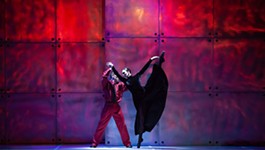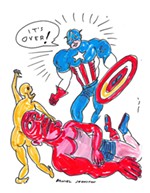The Final Three
If fast, physical action in a national face-off is what you want, try Ballet Austin
By Robert Faires, Fri., March 26, 2010
Hey, all you March Madness junkies! Tear yourself away from those brackets for a minute and listen up: There's another national contest going on right now with top-flight competitors from across the country facing off against one another and moves just as fast and physical as those on the b-ball court. And this one is taking place right here in Austin, in a venue where you sit so close to the action that you can hear every squeak of feet pushing off against the floor. What's more, there's a $20,000 purse at stake, and you actually get a say in how those thousands are awarded. You can't say that about the NCAA.
The tournament in question is Ballet Austin's New American Talent/Dance, and let's not have any snorting and rolling of the eyes over that last word; there's no cause for a hoops fan to cop an attitude about dance. Don't try to tell me that when you watch a game, the only place you look is the basket. No, you're tracking the players, and not just who's moving but how they're moving. You follow the way a player travels down the court, drives into the paint, springs into the air, makes the layup, dunks the ball. If you can appreciate the crossover dribble, the pivot, the feint, the cut, the hook, the finger roll, the fadeaway, you're already appreciating dance. It's all moves.
And in the New American Talent/Dance competition, the moves are the hoops. The finalists are three choreographers whose shots at a hunk of that $20,000 prize are directly related to how they put the Ballet Austin dancers through their paces. Each is required to create a new 20-minute work for the competition using the company's dancers – picture the Final Four without the contending teams, just their coaches, who are all forced to field players from the Longhorns – and the finished pieces are then presented together in public performances. A trio of dance professionals serves as jurors (this year, that would be Alicia Adams of the Kennedy Center, Julie Nakagawa of DanceWorks Chicago, and Paul Vasterling of Nashville Ballet), with each one getting $5,000 to allocate to one or more finalists in whatever amount(s) he or she likes. The remainder of the money goes to the audience's favorites; after each performance, $500 to whichever choreographer gets the most votes in a cell phone/texting poll.
Okay, by the standards of modern sports, even on the college level, that's chump change, but it's real money in the world of modern dance. And it comes with something even more valuable to a dancemaker: validation for a new work. See, this competition is about more than a trophy and bragging rights for the coming year; it's about giving artists an opportunity to create. As Ballet Austin Artistic Director Stephen Mills will tell you, making new work is very difficult for a choreographer. Unlike a novelist or a playwright or a composer or a painter, all of whom can create a new work in a room alone with minimal resources, a choreographer has to have dancers and a space in which they can move. And unless one belongs to a company with its own dancers and studios, as Mills does, those essentials can be hard to come by. For Mills, this contest is a means for him to take the resources to which he has ready access and share them with other artists to make new work the way he can.
Now, Mills doesn't exactly give these colleagues the run of his place, taking whatever they want and however long they want to make a new piece. Like any good athletic competition, New American Talent/Dance is bound by limitations and rules. Each choreographer has only 40 hours of studio time to develop the new work and can use no more than eight dancers in it. All three finalists have to draw from the same talent pool, the Ballet Austin company, and each gets just one hour to familiarize him- or herself with the dancers before choosing who to work with. The casting operates like a draft, with each choreographer getting to select one dancer per round. A dancer may be chosen more than once, but after one has been selected twice, his or her name is removed from the pool. The draft keeps going until all three choreographers have all the dancers they need.
Once the casting is complete, the choreographers go their separate ways, and the dances are developed at different times and sometimes in very different ways. For instance, one choreographer might assign her dancers exercises that would generate movements natural to them, and she would use those as the foundation for her choreography. Another might work from a specific movement vocabulary the way classical dancers do and base the dance in set gestures and moves. It's like the difference between a team that primarily runs plays rooted in the individual team members' skills and one that runs classic patterns based on strategy more than player ability.
And you know, on a basketball court, both approaches can win games if the coaching is strong and the players are able to execute. That's just as true in the dance studio. Exciting, engrossing choreography can come out of wildly different processes. Which means you'd be hard-pressed to look at the ways in which this year's New American Talent/Dance finalists work and predict a winner. Still, far be it from me to deny someone the pleasure of creating an office pool based on a choreography competition. If you want to handicap this year's NAT/D, here's the basics on the Final Three:
KT Nelson: co-artistic director of the San Francisco-based company ODC Dance, which she joined in 1976 and danced with for 21 years. Has choreographed 54 works for the company. Nominated for 10 Isadora Duncan Dance Awards, given to outstanding artists of the San Francisco dance community, winner of three.
Nelly van Bommel: artistic director of nøa dance and co-founder of the Reverb Dance Festival in New York. Studied at the Centre National de la Danse in Paris and the Académie de Danse Claudie Plaçais-Rocher. Teaches at the Conservatory of Dance at Purchase College, State University of New York.
Dominic Walsh: artistic director of Dominic Walsh Dance Theater, founded in 2002. Danced with Houston Ballet from 1989 to 2004. Currently in his first season as resident choreographer of Sarasota Ballet of Florida. Received a Choo-San Goh Award for Choreography for his dance Flames of Eros in 1998 and another for his dance The Trilogy: Wolfgang Amadeus Mozart in 2007.
And though it won't necessarily help you to choose a winner before you go, here's a comment from Mills that might sell you on why these three dancemakers made the finals. "The work needs to be interesting. It has to be something that's more than just putting steps together. Anybody can do that," he says. For this competition, choreographers need to have developed a singular artistic voice and have to come to it with an idea that's different or fresh. "I think these choreographers have that."
In short, sports fans, they got game.
New American Talent/Dance runs March 25-April 4, Thursdays, 7pm; Fridays & Saturdays, 8pm; Sundays, 3pm; with additional matinee Saturday, April 3, 3pm, at the AustinVentures StudioTheater, 501 W. Third. For more information, call 476-2163 or visit www.balletaustin.org.












